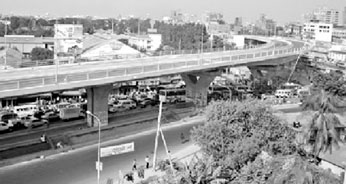
Mohakhali flyover: No respite for commuters as yet
Niamot Ali Enayet | Saturday, 22 March 2014

Success of a city predominantly depends on the efficient delivery of urban services of which efficient transportation system is of crucial importance. An adequate and efficient transport system is a pre-requisite for sustainable economic development. Dhaka is fast becoming one of the largest cities in the world. With more than 15 million people, it is also one of the most traffic congested cities in the world. By 2020, the city's population is expected to rise to 22-25 million. Rapid population increase over the past decades has rendered its transport services unable to respond to the travel needs of its residents. This increasing need has not been matched by sufficient investment in transport infrastructure, services and management. Traffic and public transport conditions in Dhaka have seriously deteriorated, characterised by daily traffic jams, traffic congestion, long delays and high incidences of road accidents.
In 1987, the Roads and Highway department first recommended construction of grade separated flyovers at four congested rail-crossing intersections in the capital. Recognising the priority, they recommended early implementation of two flyovers -- one at Mohakhali and the other at Khilgaon. On November 4, 2004 the much sought after respite appeared to be a reality with the inauguration of the Mohakhali flyover. The second flyover at Khilgaon was commissioned on March 22, 2005.
Unfortunately, introduction of these two flyovers at Mohakhali and Khilgaon intersections of the city could not bring desired results. Inadequate roadways coupled with a myriad mix of different types of vehicles, lack of proper driving behaviour and inefficient signaling system, indiscriminate on-street parking, lack of coordination among various service providers have burdened the overall situation.
The 1.12 km Mohakhali flyover was built by a Chinese firm under the World Bank funded Dhaka Urban Transport Project. Though Mohakhali is one of the busiest commercial areas in the Dhaka city, the main problem with this flyover is that it does not connect other parts of Mohakhali. DGHS (Directorate General Health Service), BCPS (Bangladesh College of Physicians and Surgeons), Government IHT (Institute of Health Technology, Dhaka), ICDDRB, BRAC University and Government Titumir College, Gausul Azam Masque and Digital Link BD are situated in Mohakhali. It is also not connected with Mohakhali bus terminal. The Mohakhali bus terminal is connected with other major districts. Thus this flyover failed to connect other parts of the capital, and for that matter it has remained unconnected with areas like greater Mymensingh.
The flyover has not met its basic objectives because of having no by-pass roads to divert access traffic. As a result, most of the buses heading towards Mohakhali clog the ramp at Banani end during rush hours every day. To add to the chaos, the unruly drivers even pick passengers at this very point in front of the traffic police. It is an everyday phenomenon at the Banani end of Mohakhali flyover that hundreds of vehicles remain stranded during peak hours. In order to get benefits from this flyover, given its existing limitations, the authorities need to connect it with Mohakhali bus terminal to facilitate movement of intercity buses out of Dhaka and vice versa.
The government has plans to construct more flyovers at the congested intersections. Construction of Mayor Mohammad Hanif flyover is already complete, negotiating over the highest number of intersections of different parts of the capital. Other mega flyover projects are also coming up. Building flyovers cost huge money but if these are ill-planned, the benefits they are meant to deliver would not reach the people. The Mohakhali flyover is a case in point. Proper planning could have eased the problems faced by the commuters.
When a new project, particularly a transport project, is taken up, the authorities should think hard so that the benefits reach the people, and that can only be done through wise and farsighted planning.
The writer is MSS student, Department of Development Studies, University of Dhaka. niamot.enayet@gmail.com